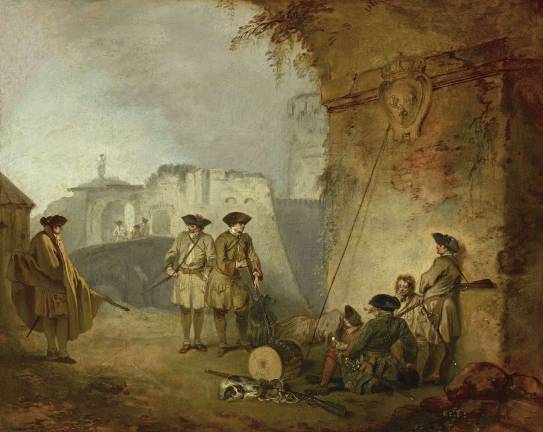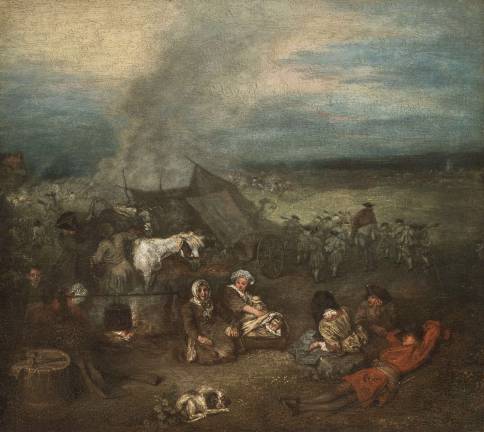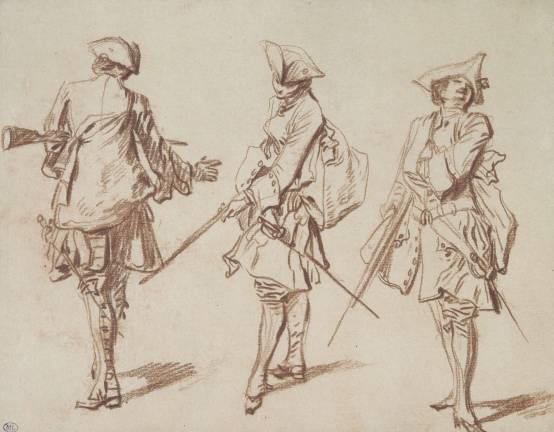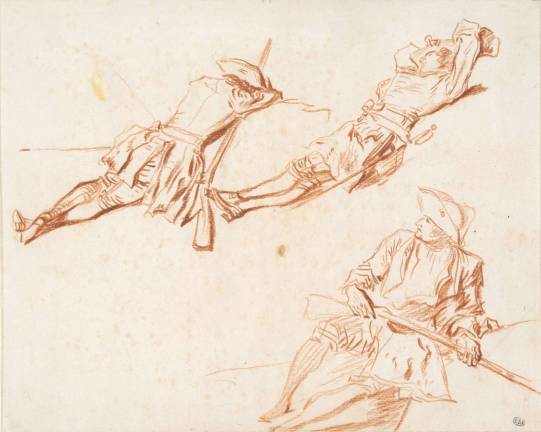Watteau and War’s Small Pleasures




BY VAL CASTRONOVO
Catherine the Great had one. So did Cardinal Silvio Valenti Gonzaga, a prominent collector. They were as famous as his amorous fête galante paintings in the 18th century, but little known today. Now they are the focus of a small show at The Frick Collection, “Watteau’s Soldiers: Scenes of Military Life in Eighteenth-Century France,” the first exhibit of its kind.
Jean-Antoine Watteau (1684-1721) was one of the period’s most renowned Rococo artists. These early paintings and drawings of common soldiers, dating from 1709 to 1715, feature men in tricorn hats and uniforms, wielding muskets and marching in line. But don’t misunderstand: these are war works minus the blood and gore. They are set on the sidelines, apart from the action. Executed for the most part during the War of the Spanish Succession (1701-1714) when Louis XIV strove to put his grandson, Philip, Duke of Anjou, on the Spanish throne, the four paintings and some dozen related drawings are quiet scenes, capturing downtime, not battle. There are seven surviving military paintings in all; the remaining three are in Russia.
As the exhibit’s curator, Aaron Wile, writes in a catalog essay, “Watteau and the Inner Life of War”: “Nothing in [the pictures] hints at a specific location or event ... little suggests the suffering a soldier would experience in war. Although marked in some ways by the War of the Spanish Succession, these are generalized images that give a mostly pleasant taste of a soldier’s routine.”
The resemblance to 17th century Dutch and Flemish genre paintings is palpable. Think of these works as military genre scenes that highlight the ordinary activities of soldiers between military engagements — soldiers at leisure pictured sleeping, daydreaming, smoking, playing cards, conversing and even eyeing the opposite sex, because women (wives, mistresses, prostitutes) were present in the camps.
Actual fighting is only hinted at in a very few paintings (e.g., “The Line of March,” ca. 1710), with a flash of light or billowing smoke in the distance. It is the subjects’ humanity, instead, that interested Watteau, who was clearly influenced by the writers and philosophers of the period who were charting psychological territory. “Watteau shows a specific side of war,” Wile said at a preview of the exhibit. “He goes for the depiction of the individual with an inner life.” He added: “They are outside battle, on their own time. The intimacy between the soldiers is new.”
But all is not as it seems. Close inspection reveals some stilted encounters between the individuals, the curator says. There is a lack of connection — gazes that don’t quite meet — that stems from the artist’s peculiar working method. He eschewed preliminary compositional studies and the depiction of a harmonious whole. He preferred sketching individual soldiers from life without an end goal.
Watteau kept notebooks with red chalk drawings of figures in motion and figures at rest — individual studies of military men in a wide variety of poses. They stand, sit, kneel, lie on their bellies and lie on their backs. They are seen from the front, from behind and sideways. Some hold muskets, others drums. Some preen, others retreat into themselves.
He plucked these isolated figures from his notebooks and dropped them into his paintings, creating new configurations and narratives but a sense of mystery and ambiguity, too, as the people don’t always “relate.”
“Nothing quite coheres,” Wile said, using “The Supply Train” (ca. 1715), a recently rediscovered work, to illustrate the point. The subjects — soldiers, women, a baby, a horse and a dog — are sprawled across the panel in a haphazard way, perhaps a comment on the “aimlessness of camp life,” according to the exhibit text, but, unlike works by Goya in the 19th century or Picasso in the 20th, conveying no moral opinion about war. The works were created to please viewers, not provoke.
“The Portal of Valenciennes” (ca. 1710-11), acquired by The Frick in 1991, is a rare guard picture and the show’s enigmatic centerpiece (note: title aside, it is unclear whether the scene is actually rooted in Valenciennes, Watteau’s hometown). Bathed in a soft light, the small painting depicts two sets of soldiers conversing; two other figures are seated, while a third sleeps on his stomach. The curator said that the scene is “less resolved than it seems. The expressions are impossible to read.” Boredom is a distinct possibility.
In a key observation, Wile links the fêtes galantes and the military works, courtly love and military life: “War and love ... are not so dissimilar in Watteau’s universe, for if love joins people together, so does war — not only for companionship but, more fundamentally, for survival,” he writes. “In this sense, both the military works and the fêtes galantes offer a vision of coexistence within a community, but it is a fragile coexistence.”
Watteau’s genius, the curator concludes, is in capturing these fragile connections and offering “the essentially modern insight that society is held together by only the thinnest of threads.”